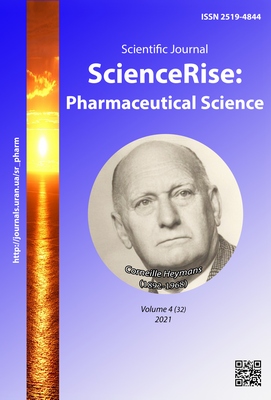Компонентний склад ефірної олії пагонів та листя Laurus nobilis L. української заготівлі
DOI:
https://doi.org/10.15587/2519-4852.2021.239335Ключові слова:
лавр благородний, пагони, листя, ефірна олія, 1,8-цинеол, α-терпинилацетат, спатуленол, метилевгенолАнотація
Метою нашого дослідження провести порівняльний аналіз ефірних олій пагонів та листя лавру благородного української флори та визначити перспективи їх застосування у фармації.
Матеріали та методи. Сировина для отримання ефірної олії (пагони і листя) лавру благородного заготовлена в листопаді 2017 року південних районів України.
Методом хромато-мас-спектрометрії з використанням хроматографа Agilent Technology 6890N, досліджено та ідентифіковано компонентний склад 4 зразків ефірної олії сировини лавру благородного.
Компонентний склад ефірної олії ідентифікували методом порівняння результатів з даними бібліотеки мас-спектрів NIsT 02 (більше, ніж 174 000 речовин).
Результати. Так, в досліджуваних серіях ефірної олії пагонів спостерігалась схожість, як за набором компонентів, так й за відносним вмістом ряду окремих сполук та сполук структурно-споріднених груп. За вмістом в цих зразках домінували 1,8-цінеол (19,63 % від суми та 12,93 % від суми, відповідно), α-терпинілацетат (16,22 % та 16,03 %, відповідно).
На відміну від ефірної олії двох серій пагонів, компонентний склад ефірної олії двох серій листя значно різнився. В обох досліджуваних серіях винайдено лише 3 сполуки, що є загальними – це ароматичні сполуки метилевгенол, транс-метилізоевгенол та секвітерпеноїд каріофіленоксид.
Висновки. Таким чином, порівняльний аналіз компонентного складу біологічно активних речовин в ефірній олії пагонів та листя лавру благородного української заготівлі показав перспективність подальшого фармакогностичного дослідження цієї рослини як джерела лікарської сировини
Посилання
- Laurel noble (Laurus nobilis). Available at: https://lektrava.ru/encyclopedia/lavr-blagorodnyy/
- Barroso, W., Duarte Gondim, R., Marques, V., Lael, M., Santos, P., Oliveira Castro, A. et. al. (2018). Pharmacognostic Characterization of Laurus nobilis L. Leaves. Journal of Chemical and Pharmaceutical Research, 10 (1), 30–37. Available at: https://www.jocpr.com/archive/jocpr-volume-10-issue-1-year-2018.html
- Basak, S. S., Candan, F. (2013). Effect of Laurus nobilis L. Essential Oil and its Main Components on α-glucosidase and Reactive Oxygen Species Scavenging Activity. Iranian journal of pharmaceutical research, 12 (2), 367–379. Available at: http://www.ncbi.nlm.nih.gov/pmc/articles/PMC3813252
- Muñiz-Márquez, D. B., Wong-Paz, J. E., Contreras-Esquivel, J. C., Rodríguez-Herrera, R., Aguilar, C. N. (2018). Bioactive compounds from bay leaves (Laurus nobilis) extracted by microwave technology. Zeitschrift Für Naturforschung C, 73 (9-10), 401–407. doi: http://doi.org/10.1515/znc-2018-0009
- Mansour, O., Darwish, M., Ismail, G., Douba, Z., Ismaeel, A., Eldair, K. (2018). Review Study on the Physiological Properties and Chemical Composition of the Laurus nobilis. The Pharmaceutical and Chemical Journal, 5 (1), 225–231. Available at: https://www.researchgate.net/publication/323883941_Review_Study_on_the_Physiological_Properties_and_Chemical_Composition_of_the_Laurus_nobilis
- Bayramoglu, B., Sahin, S., Sumnu, G. (2009). Extraction of Essential Oil from Laurel Leaves by Using Microwaves. Separation Science and Technology, 44 (3), 722–733. doi: http://doi.org/10.1080/01496390802437271
- Furtado, R., Baptista, J., Lima, E., Paiva, L., Barroso, J. G., Rosa, J. S., Oliveira, L. (2014). Chemical composition and biological activities of Laurus essential oils from different Macaronesian Islands. Biochemical Systematics and Ecology, 55, 333–341. doi: http://doi.org/10.1016/j.bse.2014.04.004
- Boughendjioua, H. (2017). Effective antifungal and antioxidant properties of essential oil extracted from the leaves of Laurus nobilis L. wild-growing in Algeria. International Journal of Biosciences, 11 (4), 164–172. Available at: http://doi.org/10.12692/ijb/11.4.164-172
- Fidan, H., Stefanova, G., Kostova, I., Stankov, S., Damyanova, S., Stoyanova, A., Zheljazkov, V. D. (2019). Chemical Composition and Antimicrobial Activityof Laurus nobilis L. Essential Oils from Bulgaria. Molecules, 24 (4), 804. doi: http://doi.org/10.3390/molecules24040804
- Kovacevic, N. N., Simic, M. D., Ristic, M. S. (2007). Essential oil of Laurus nobilis from Montenegro. Chemistry of Natural Compounds, 43 (4), 408–411. doi: http://doi.org/10.1007/s10600-007-0150-x
- Caputo, L., Nazzaro, F., Souza, L., Aliberti, L., De Martino, L., Fratianni, F. et. al. (2017). Laurus nobilis: Composition of Essential Oil and Its Biological Activities. Molecules, 22 (6), 930. doi: http://doi.org/10.3390/molecules22060930
- Bhouri, N., Debbabi, F., Ben Salem, I., Ben Abdessalem, S. (2018). Exploitation of essential oil extracted from TunisianLaurus nobilisfor the development of PET antibacterial sutures. The Journal of The Textile Institute, 109 (10), 1282–1292. doi: http://doi.org/10.1080/00405000.2017.1423006
- Marques, A., Teixeira, B., Nunes, M. L. (2016). Bay Laurel (Laurus nobilis) Oils. Essential Oils in Food Preservation, Flavor and Safety, 239–246. doi: http://doi.org/10.1016/b978-0-12-416641-7.00026-2
- Kaur, M., Chahal, K., Kumar, A., Kaur, R. (2018). Nematicidal activity of bay leaf (Laurus nobilis L.) essential oil and its components against. Meloidogyne incognita. Journal of Entomology and Zoology Studies, 6 (2), 1057–1064. Available at: https://www.semanticscholar.org/paper/Nematicidal-activity-of-bay-leaf-(Laurus-nobilis-Kaur-hahal/5dfc8d9147215198bcc8417489b91ff77f92a9f2
- Fonseca, B., Mestre, V. F., Colaço, B., Pires, M., Martins, T., Gil da Costa, R. et. al. (2018). Laurus nobilis (laurel) aqueous leaf extract's toxicological and anti-tumor activities in HPV16-transgenic mice. Food & Function, 9, 4419–4428. doi: http://doi.org/10.1039/c8fo00783g
- Kivçak, B., Mert, T. (2002). Preliminary evaluation of cytotoxic properties of Laurus nobilis leaf extracts. Fitoterapia, 73 (3), 242–243. doi: http://doi.org/10.1016/s0367-326x(02)00060-6
- Siriken, B., Yavuz, C., Guler, A. (2018). Antibacterial Activity of Laurus nobilis: A review of literature. Medical Science and Discovery, 5 (11), 374–379. doi: http://doi.org/10.17546/msd.482929
- Fernandez, C. M. M., da Rosa, M. F., Fernandez, A. C. A. M., Lorenzetti, F. B., Raimundo, K. F., Cortez, D. A. G. et. al. (2018). Larvicidal activity against Aedes aegypti of essential oil of Laurus nobilis leaves obtained at different seasons. Journal of Essential Oil Research, 30 (5), 379–387. doi: http://doi.org/10.1080/10412905.2018.1473294
- Tabanca, N., Avonto, C., Wang, M., Parcher, J. F., Ali, A., Demirci, B. et. al. (2013). Comparative Investigation of Umbellularia californica and Laurus nobilis Leaf Essential Oils and Identification of Constituents Active against Aedes aegypti. Journal of Agricultural and Food Chemistry, 61 (50), 12283–12291. doi: http://doi.org/10.1021/jf4052682
- Kyslychenko, A., Dyakonova, Ya., Alexandrov, A., Darmogray, R. (2008). Gas chromatography with mass-spectrometric detection of the components of the essential oils from Achillea carpatica Blocki ex Dubovik and Echinaceae pallida (Nutt.) Herba Polonica Journal, 54 (4), 62–67. Available at: http://www.herbapolonica.pl/articles/view/38
##submission.downloads##
Опубліковано
Як цитувати
Номер
Розділ
Ліцензія
Авторське право (c) 2021 Olga Khvorost, Irina Posohova, Juliia Fedchenkova, Kateryna Skrebtsova

Ця робота ліцензується відповідно до Creative Commons Attribution 4.0 International License.
Наше видання використовує положення про авторські права Creative Commons CC BY для журналів відкритого доступу.









